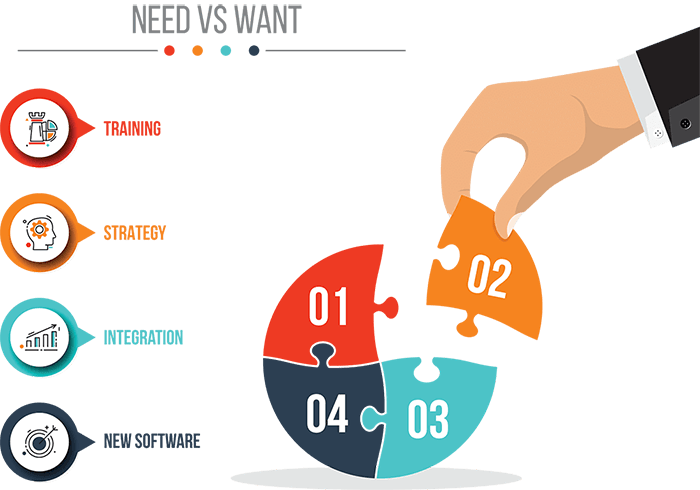Differentiating Between Need vs. Want
In this digital age, we are often drawn into new trends and the “next” technology that’s going to boost our business up a level. It’s easy to forget in the rush of our desire to stay ahead of the curve or “evolve” some aspect of the business, that we need to reinforce our foundation before committing to the growing weight of more campaigns, more technology, more services, more…everything.

Blinded by the Light
Picture your business in your mind (or look around if you’re already there). Did you notice the leak? Or the “out of order” sign on a dusty machine shoved awkwardly in the corner somewhere? Did your attention turn to the heavy, automatic sighs of a coworker having to employ some daily workaround to gloss over some pesky error that pops up on a lead form every single time? Probably not.
Instead, you most likely envisioned current company goals and objectives for next quarter. Or turned to an exciting new campaign or service that promises to be a game changer. Maybe your thoughts drifted to the new computer package that’s on its way to update an antiquated, old system.
The reality is that we’re all prone to be “blinded by the light” of the new, up-and-coming, promises of the future. And although all those things could potentially make a difference to your business, it’s important to step back and consider first what is truly NEEDED in your business.
Evaluate Methodically

Start by examining your foundations to identify those things that are slow, out of date, only partially used, or just plain broken. Examine whether essential elements are missing or whether processes need updating. Think of it as an audit on your day-to-day processes and environment of sorts. Try to get a holistic look of the business from a variety of perspectives so you have an up-to-date snapshot of the state of things.
Then, step back and select your three biggest martech problems. These pain points will be different for each company and depend on the moment you take your state-of-the-company audit. The beautiful thing about identifying your big foundational problems right now is that you can be very targeted about solving those issues in the next steps. You may know that you need to scale faster, that your web analytics are lacking, or that you need better lead generation. Whatever the issue, start there.
Establish or Strengthen Foundation
Everyone knows that you need a solid foundation to build anything. That’s true of a successful marketing tech program as well. Before adding the exciting new tools and technology, make sure you have established or strengthened your martech basics, which should include CRM, marketing automation, content management, and analytics. You may find that by shoring up these tools alone, you can alleviate some or all of the pain points identified above.
Using a tool such as a marketing sensitivity analysis can help you drill down to see what parts of your foundational technology need a little tuning up or even a complete overhaul. The idea is that you take a customized, unique approach to address existing issues that will deliver the components that you truly need to make your business successful.
Steal from the Best
Many successful companies are addressing this same question, and it’s always beneficial to look at best practices within your industry. Take a look at the wealth of ideas and innovations already in motion to learn and help broaden your perspective on what possible solutions may already exist to address your own company’s issues.
Remember to keep your mind focused on your three priorities and your foundational needs; it can be easy to get carried away to your wants while doing this exercise.
Some Essentials to Consider
The sheer volume of martech tools and technology available today can be overwhelming for a company starting from scratch or even one trying to regroup. Few martech vendors are selling simple solutions anymore; instead, they try to include as many new features as possible to snatch a sustainable slice of the market. The challenge, then, becomes a delicate balancing act of ensuring that you have the tools to build a solid foundation without getting caught in the whirlwind of fascinating add-ons.
Consider these martech tools that every marketing team should employ at a basic level:

- Email Marketing. For many businesses, email still plays an important role in reaching both prospects and customers. Many automation tools exist to help you maximize this channel.
- Social Media. There’s no doubt that a wide range of social media channels can help reach and nurture new and existing audiences.
- Content Management. Whether you’re publishing blogs, training material or white papers, content continues to be king in helping to illustrate your organization’s expertise in your market.
- CRM. Keeping track of your lead lifecycle through a solid CRM is critical to reaching your prospects when and where they are most likely to engage.
- Analytics. Nothing can be improved without measurement. Finding the tools and mathematical models to give you the right data at the right time to make better business decisions is critical.
- Automation. In order to scale and respond swiftly, you’ll need some automation tools to help you work faster and more efficiently.
These martech tools are the basic building blocks of any successful marketing program today. However, each tool has the potential to lead you off the beaten path, tempting you to explore the latest and greatest interesting sub-feature. Remember that every tool and technology requires team members to not only manage it but also demands that all the members of your organization understand and utilize it appropriately to gain the promised returns. Carefully weigh those required investments of time, training and resources before taking on new technology.
Time for Wants
Once your foundation is established, strong and solid, you can consider adding a few items from your list of “wants.” What new campaigns and goals do you want to see come to fruition? You may want to build campaigns that can better nurture your marketing prospects, create mind-blowing experiences for your current customers, or using gamification to engage those in the top of your lead lifecycle funnel.
Once these WANTS are clearly defined, targeted changes can be planned. Just like in a housing remodel project, your business needs to have firm foundations to be able to accommodate growing business WANTS. Without that firm foundation, you may find that implementing a WANT triggers the cost of also resolving a NEED.